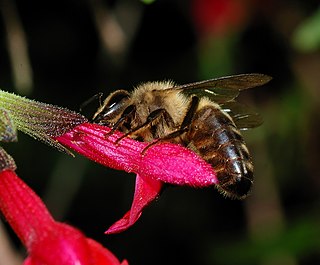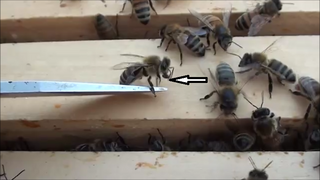
Beekeeping is the maintenance of bee colonies, commonly in man-made beehives. Honey bees in the genus Apis are the most commonly kept species but other honey producing bees such as Melipona stingless bees are also kept. Beekeepers keep bees to collect honey and other products of the hive: beeswax, propolis, bee pollen, and royal jelly. Other sources of beekeeping income include pollination of crops, raising queens, and production of package bees for sale. Bee hives are kept in an apiary or "bee yard".

The European dark bee is a subspecies of the western honey bee, evolving in central Asia, with a proposed origin of the Tien Shan Mountains and later migrating into eastern and then northern Europe after the last ice age from 9,000BC onwards. Its original range included the southern Urals in Russia and stretched through northern Europe and down to the Pyrenees. They are one of the two members of the 'M' lineage of Apis mellifera, the other being in western China. Traditionally they were called the Black German Bee, although they are now considered endangered in Germany. However today they are more likely to be called after the geographic / political region in which they live such as the British Black Bee, the Native Irish Honey Bee, the Cornish Black Bee and the Nordic Brown Bee, even though they are all the same subspecies, with the word "native" often inserted by local beekeepers, even in places where the bee is an introduced foreign species. It was domesticated in Europe and hives were brought to North America in the colonial era in 1622 where they were referred to as the English Fly by the Native Americans.

Varroa destructor, the Varroa mite, is an external parasitic mite that attacks and feeds on honey bees and is one of the most damaging honey bee pests in the world. A significant mite infestation leads to the death of a honey bee colony, usually in the late autumn through early spring. Without management for Varroa mite, honey bee colonies typically collapse within 2 to 3 years in temperate climates. These mites can infest Apis mellifera, the western honey bee, and Apis cerana, the Asian honey bee. Due to very similar physical characteristics, this species was thought to be the closely related Varroa jacobsoni prior to 2000, but they were found to be two separate species after DNA analysis.

The Russian honeybee refers to honey bees that originate in the Primorsky Krai region of Russia. This strain of bee was imported into the United States in 1997 by the USDA Agricultural Research Service's Honeybee Breeding, Genetics & Physiology Laboratory in Baton Rouge, Louisiana, in response to severe declines in bee populations caused by infestations of parasitic mites, and has been used in breeding programs to improve existing stocks. Many Russian queens openly mate with drones from various stock, creating colonies that are genetically hybrid. Some of these 'uncontrolled' hybrids may exhibit "increased aggressiveness, reduced honey production and a decrease in their ability to withstand mites and detrimental expressions of other traits as well."

Varroa is a genus of parasitic mesostigmatan mites associated with honey bees, placed in its own family, Varroidae. The genus was named for Marcus Terentius Varro, a Roman scholar and beekeeper. The condition of a honeybee colony being infested with Varroa mites is called varroosis.

May Roberta Berenbaum is an American entomologist whose research focuses on the chemical interactions between herbivorous insects and their host plants, and the implications of these interactions on the organization of natural communities and the evolution of species. She is particularly interested in nectar, plant phytochemicals, honey and bees, and her research has important implications for beekeeping.

The western honey bee or European honey bee is the most common of the 7–12 species of honey bees worldwide. The genus name Apis is Latin for "bee", and mellifera is the Latin for "honey-bearing" or "honey carrying", referring to the species' production of honey.

Everett Franklin Phillips (1878-1951) was an American apiculturist, scholar, and innovator in the beekeeping field.

Commercial Beekeeping in the United States dates back to the 1860s.

Beekeeping in New Zealand is reported to have commenced in 1839 with the importing of two skep hives by Mary Bumby, a missionary. It has since become an established industry as well a hobby activity.

Colony collapse disorder (CCD) is an abnormal phenomenon that occurs when the majority of worker bees in a honey bee colony disappear, leaving behind a queen, plenty of food, and a few nurse bees to care for the remaining immature bees. While such disappearances have occurred sporadically throughout the history of apiculture, and have been known by various names, the syndrome was renamed colony collapse disorder in early 2007 in conjunction with a drastic rise in reports of disappearances of western honey bee colonies in North America. Beekeepers in most European countries had observed a similar phenomenon since 1998, especially in Southern and Western Europe; the Northern Ireland Assembly received reports of a decline greater than 50%. The phenomenon became more global when it affected some Asian and African countries as well.
Varroa sensitive hygiene (VSH) is a behavioral trait of honey bees (Apis mellifera) in which bees detect and remove bee pupae that are infested by the parasitic mite Varroa destructor. V. destructor is considered to be the most dangerous pest problem for honey bees worldwide. VSH activity results in significant resistance to the mites.
Beekeeping is first recorded in Ireland in the seventh century. It has seen a surge in popularity in modern times, with the membership of beekeeping associations exceeding 4,500. The median average number of hives per beekeeper is three hives, while the average honey output per hive is 11.4 kg. The growth in the practice has occurred despite increased pressures on bees and beekeepers due to parasites, diseases and habitat loss.

The Apiary Laboratory, more often referred to as the Apiary, is a research laboratory at the University of Massachusetts Amherst. Originally built for the study of honey bees and apiculture, today it is primarily used to study native pollinator species and the chemicals and pathogens impacting their populations. This academic building is unique in that it is credited as being the first in the United States to be erected exclusively for the teaching of beekeeping.
Dr. Marian Jeliński was born in Siemirowice, in 1949. Jeliński is a recognized authority in bee diseases and an active member of the Kashubian community. He is involved in a range of activities focusing on the preservation of the Kashubian language and culture. Jeliński is also known for his support of Kashubian embroidery and building bridges between Kashubian communities in Poland and Canada. He and his wife, Alicja, have two sons and currently live in Żukowo, near Gdańsk, Poland.

Thomas Dyer Seeley is the Horace White Professor in Biology in the Department of Neurobiology and Behavior at Cornell University. He is the author of several books on honeybee behavior, including Honeybee Democracy (2010) and The Wisdom of the Hive (1995) He was the recipient of the Humboldt Prize in Biology in 2001. He primarily studies swarm intelligence by investigating how bees collectively make decisions.

Beekeeping in Australia is a commercial industry with around 25,000 registered beekeepers owning over 670,000 hives in 2018. Most are found in the eastern states of Queensland, New South Wales, Victoria and Tasmania as well as the south-west of Western Australia.

Mite Biting is claimed to be a natural defensive behavior of some honey bees to fight off the ectoparasitic mites Varroa destructor. This behavior has been studied since the late 1990s for honeybee breeding and improvement of honeybee stocks towards mite resistance. Krispn Given and Dr. Greg Hunt at Purdue University started a hierarchical selective breeding program in 1997–present for increased mite-biting/grooming behavior of European honey bee. A group of Midwest bee breeders visiting the Purdue bee lab were inspired to start the Heartland Honey Bee Breeders Cooperative as a result of their work.
Friedrich Ruttner was an Austrian SA-member, NSDAP member, SS-physician, neurologist, zoologist and bee expert. He became internationally known for his advances in honey bee breeding, instrumental insemination, classification of various subspecies and as a co-founder of Apidologie.














